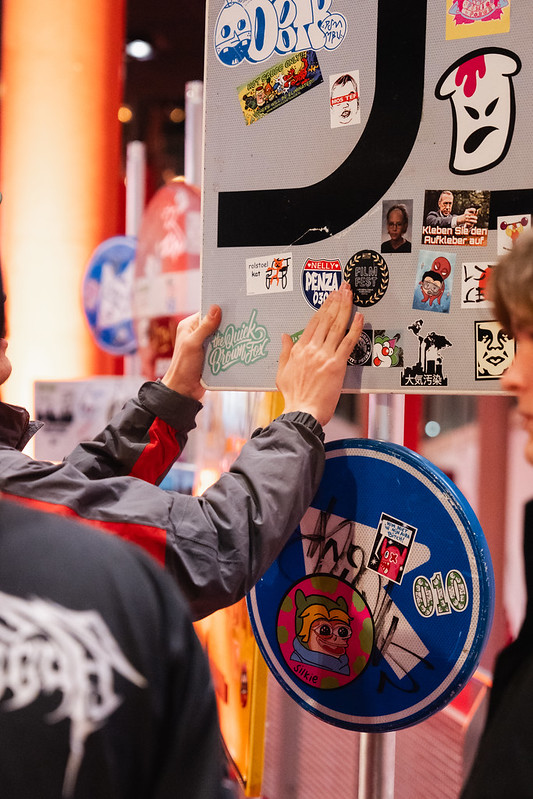I recently was in Breda, The Netherlands, to attend the screenings of the Blind Walls Film Fest. Organized by Blind Walls Gallery, the event brought the best of visual storytelling dedicated to graffiti, street art, and muralism to the big screen, and there were plenty of opportunities for discussions with artists and filmmakers.
Grab your popcorn and get comfortable because today we’re going to talk about all the amazing movies and shorts I’ve watched over the weekend of Blind Walls Film Fest 2023!
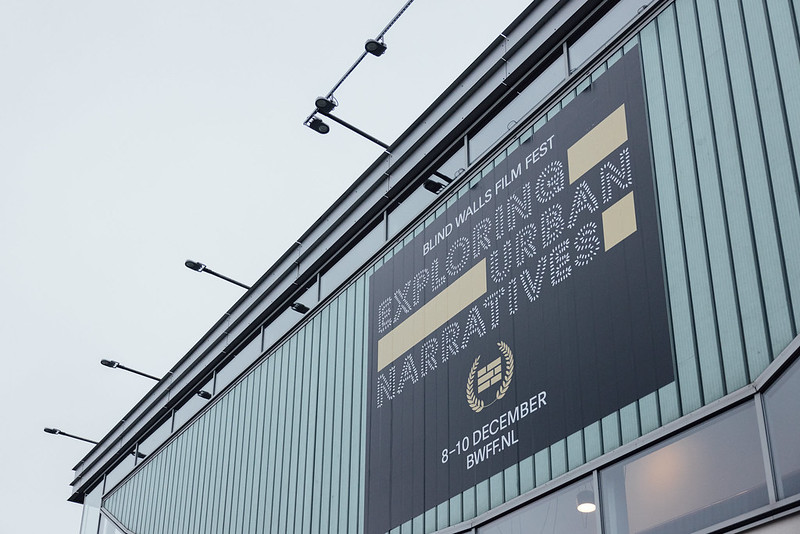
Since its debut in 1983, the film “Wild Style” has played a pivotal role in documenting and popularizing hip-hop culture. Alongside Tony Silver’s “Style Wars,” “Wild Style” showed that a graffiti piece is much more than letters on a subway car; it embodies an entire culture that, thanks to these two films, has expanded all around the globe.
In the decades following, the importance of video documentation and storytelling in capturing the essence of graffiti, street art, and muralism has steadily increased. This is not only due to the ephemeral nature of the artform, necessitating video documentation to preserve its memory, but also because, in today’s age of digital communication, video emerges as the most potent medium for narrating the story behind a street art piece. It allows us to move beyond the artwork on a wall, transforming the creation process into a compelling narrative.
For the second edition of the Blind Walls Film Fest, the amazing team at Blind Walls Gallery meticulously curated a collection of engaging narratives spanning the entire spectrum of urban creativity. They also assembled a selection of short films that felt like tiny treasures. Each title was exceptionally captivating, so let’s delve into them one by one.
Whenever available, I’ll include a link to the full movie: with the winter holidays approaching, you’ll have plenty of time to enjoy the outstanding selection crafted by Dennis Elbers and his lovely team at Blind Walls Gallery!
Blind Walls Film Fest: Day 1
After delving into their poetics and creative process, Kristina Borhes from MZM Projects presented a selection of their (street) art videos, encompassing artist portraits and the noteworthy “Imaginary City,” dedicated to Nuart Festival’s hometown, Stavanger, Norway.
Marked by ambient music and slow camera movements, MZM Projects’ aesthetics and storytelling exude a notable sense of poetry. As I watched videos spanning various stages of their career, I gained a deeper appreciation for their artistic evolution. This included shifts in creative directions, such as the growing prominence of Kristina’s authorial voice, infusing warmth and a personal touch into the narrative, in contrast to a more cold and detached approach. Additionally, going against the “genre” of urban movies, which often boasts speed action motion, in the evolution of their aesthetics there was a noticeable deceleration in the camera movement, eventually becoming so smooth to evoke the sensation of fingertips gliding on silk.
What stood out were their meticulous observations of details that many other directors might overlook as insignificant. Yet, in the context of their films, these details transformed into powerful storytelling moments. Kristina even coined a term for these instances: the “ostensive insignificance of the moments.” This distinctive feature has become a trademark of their aesthetics.
All in all, I found this selection of works highly interesting, although I was somewhat disappointed that “Tales from the Silver City,” their fairytale anthology shot at Nuart Aberdeen, was not included.
MZM Projects’ “Imaginary City” | Full Movie:
You are welcome ;)
The festival officially kicked off right after with the most stunning opening credits ever. Rotterdam-based artists Thomas & Jurgen crafted a live performance, complete with live music. Spectacular!
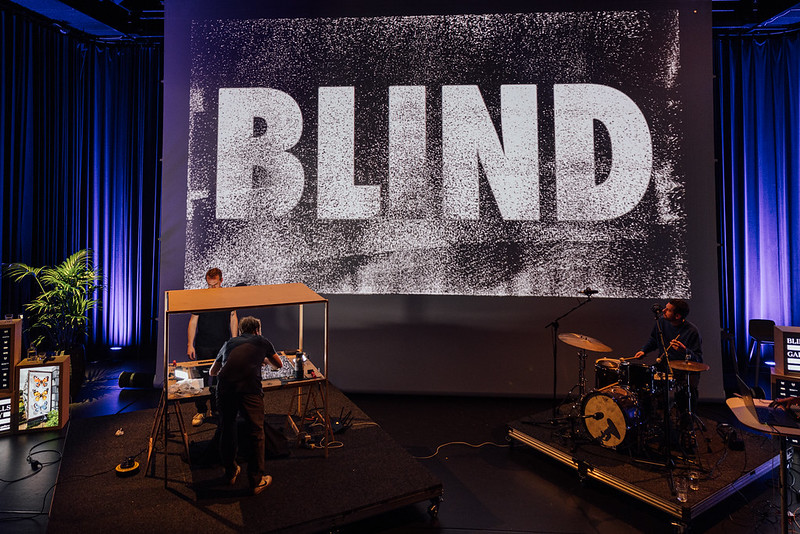
“Painting Dhaka” by Lukas Zeilinger
Right after, the first officially competing film began: “Painting Dhaka,” by Berlin-based director and graffiti writer Lukas Zeilinger. “Painting Dhaka” is a unique graffiti movie, primarily because it doesn’t focus on graffiti as a culture, but rather uses it as a lens to address the authoritarian regime in Bangladesh and living conditions in the slums of one of the world’s poorest countries. With an ironic language and highly creative storytelling, Lukas recounts his experience as an educator in some schools in Dhaka, where he conducted graffiti workshops with young students in places marked as “unknown roads” on Google Maps (an app that plays a role in the story, just like Alexa).
“Painting Dhaka” is a societal critique documentary that speaks to our tendency to turn away, knowing that in Bangladesh, kids are forced to work, and even the chance to dream and hope is taken away from them. Lukas’ social analysis starts with the question: in such a poverty-stricken place, can graffiti be something more than a vain game?
The author shares that graffiti changed his life, teaching him a new sense of identity, and this is precisely the goal he sets when he begins the workshops with the kids. Upon arriving in Dhaka, however, unforeseen events and setbacks arise. Still, Lukas, armed with perseverance (another quality learned through graffiti because actions don’t always go as planned, or they don’t succeed on the first try), stays in Dhaka to pursue his goal, using the waiting time to deepen his understanding of such a challenging country and to shoot a documentary about what he was discovering regarding corruption and the authoritarian regime of the country.
The movie is incredibly fun and ironic despite the dramatic topic. It is truly empathetic towards the kids, to whom Lukas imparts the power of art and creativity as a tool to unleash imagination (before participating in this graffiti workshop, the children had only drawn scenes of the war of independence, flags, and monuments; they were unfamiliar with the concept of drawing as a creative activity).
The movie stands out for its inventive presentation, from start to end credits (where you’ll find a brilliantly witty “Made in Bangladesh” with symbols of a washing machine and an iron, just like on T-shirts).
After the film screening, Lukas takes a seat on the stage alongside cultural journalist Jaap van der Doelen for a Q&A. However, right after the first question, festival director Dennis Elbers interrupts the interview with a plot twist.
Veronique van Zanten, the head of the festival jury, steps onto the stage and announces that indeed, “Painting Dhaka” is the winner of the Blind Walls Film Fest 2023!
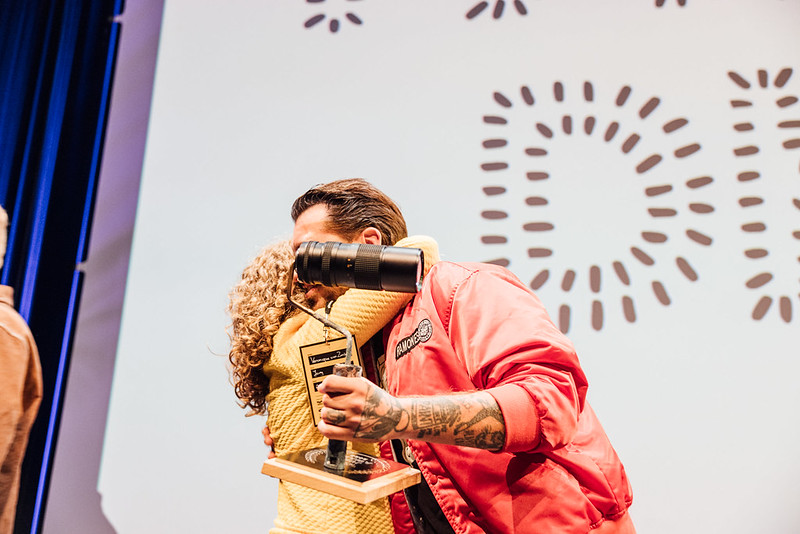
“Rocco und seine Brüder” by Lukas Ratius and Philipp Majer
Although the award had already been handed out, the film festival must go on, and so we settled back into our seats for “Rocco und seine Brüder,” a documentary on the Berlin-based graffiti writer Rocco and his crew.
Renowned for pushing graffiti beyond mere bombing, Rocco and his brothers set up numerous art installations with socio-political themes. The city is their playground: their installations come to life on the streets, arranged through camouflage – with them donning worker disguises complete with hi-res vests – provocatively challenging those who happen to be in the vicinity.
From subvertising campaigns against Airbnb, the culprit behind Berlin’s gentrification, to an illicit theater performance within the subway tunnels, and an art installation at the Urban Art Biennale, their creations are firmly grounded in graffiti for the illicit nature and audacious methods involved.
The movie ends with their transformation of a Berlin car train into a colossal piñata (complete with candy!) – showcasing just how far they venture from traditional style writing.
“Rocco und seine Brüder” | Full Movie:
You are welcome ;)
Following a lively Q&A session with the filmmakers, we made our way to the foyer, where DJ EZD spun some nice beats. Here, the crew from Blind Walls Gallery had arranged street signs, which, over the weekend, became tagged over and covered in stickers.
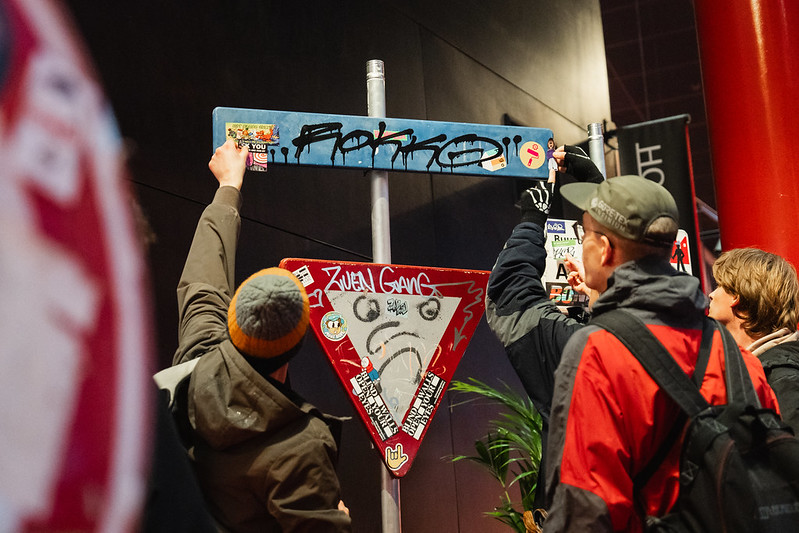
Additionally, an exhibit by the Dutch Graffiti Library was on display, accompanied by screens showcasing behind-the-scenes footage, plunging the audience into the artistic world of Otto Baum. The German street artist made a lasting impact with a mural embellishing Breda’s Chasse Cinema, our home for the weekend.
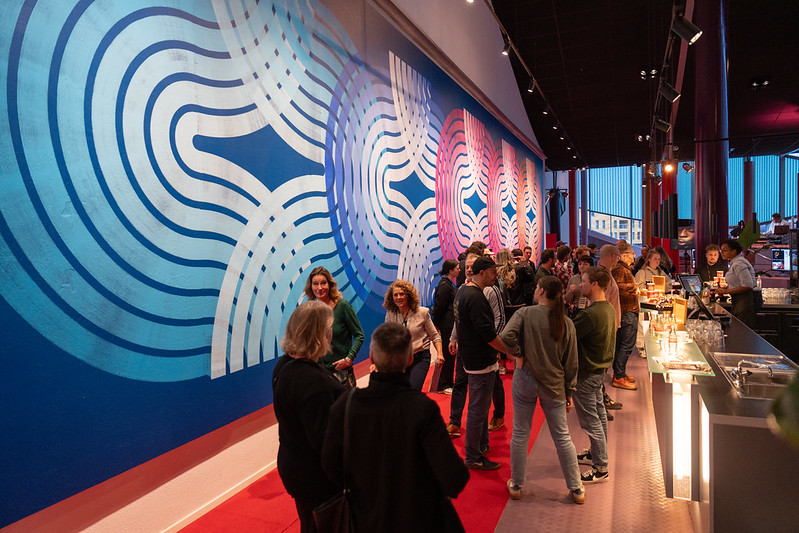
Indeed, this is quite a special project curated by Blind Walls Gallery: annually, a different artist transforms the wall in the foyer of the small auditorium, drawing inspiration from the theater for the design. In the early months of 2023, Otto Baum crafted a special tool to paint a dynamic and monumental pattern on this expansive surface.
I find this mural mesmerizing!
Blind Walls Film Fest: Day 2
Launching into the second day of the Blind Walls Film Fest was the much-anticipated (at least, by myself) “Sticker Movie,” a tribute to sticker culture across the globe. Centering on these small, portable works of art found everywhere in our city’s urban landscape, the film provides a thorough exploration of a facet of urban culture that is frequently overlooked but is, in fact, fundamental to the entire movement.
“Sticker Movie” by Will Deloney and Sha-Risse R. Smith
Above all, the movie sheds light on the underground network of sticker enthusiasts and addicts, offering insights through numerous interviews with sticker artists worldwide. This includes Shepard Fairey, also known as OBEY, who, in 1989, created a sticker featuring the now-iconic image of former wrestler Andre Roussimoff alongside the phrase ‘Andre the Giant has a Posse.’ It can be said that this simple sticker, born to impress his art school and skateboard friends, marked not only the beginning of OBEY’s artistic career but, in a sense, the inception of the entire street art movement.
During the interview with Shepard Fairey, what resonated with me most was his admission of never leaving home without a few stickers in his pocket. It’s fascinating to see that, despite the monumental global success he has achieved with his XXL murals, solo exhibitions, clothing brand, and the Obama campaign, his top priority remains slapping that sticker onto a lamppost. This kind of passion and dedication permeates the entire film—a shared enthusiasm that unites people from diverse backgrounds, ages, ethnicities, and religions. They express similar sentiments, not only about the subculture they represent but also about the role it has played in their personal lives; many have attested that this passion for drawing and sticking stickers has been instrumental in helping them cope with their mental health struggles.
The standout element of the movie for me was the use of “talking heads” created by animating iconic stickers from various artists. Given that many artists preferred to remain anonymous, coupled with the constraints of the pandemic, which prevented in-person interviews, the filmmakers had to devise a creative solution. Their ingenious idea involved animating the stickers, allowing them to “speak” through audio recordings sent in by numerous sticker artists worldwide, who responded to the same set of questions. By gathering a diverse array of opinions and perspectives from different continents, the filmmakers were able to depict this multifaceted movement, and its overarching goal to transform every corner into an art gallery, turning seemingly mundane activities like grocery shopping into enjoyable experiences.
Most of all, “Sticker Movie” is a love letter to the sticker community—a community that is lively, authentic, and truly wonderful. In contrast to the rivalry and competition often found in the world of graffiti, sticker artists exhibit warmth, camaraderie, and a strong sense of support for one another.
“Behind the Wall” by Deborah Faraone Mennella
Up next was “Behind the Wall,” a documentary movie following Dutch muralist Judith de Leeuw aka JDL between Amsterdam and Taranto, Italy.
The film provides an intimate documentation of the meticulous creation of one of Judith’s monumental murals, capturing every step from conception and photoshoot to the finalization of the wall. Executed in Taranto, this mural holds profound significance for Judith, as it emerged after the passing of her father. The title (“Love is Stronger than Death,” a phrase derived from the Torah) is a sentence her father often repeated following his cancer diagnosis. The mural depicts a girl supported by masculine hands, belonging to a man whose face remains unseen, conveying the message that our loved ones stand by us even when we can no longer see them. The film delves into the intricate relationship between Judith and her father—from her departure from home at a young age to the Rotterdam mural dedicated to the fight against cancer, painted a few months before her father’s death.
However, more than just a tribute, the Taranto mural and Judith’s entire career, as per the artist’s own admission, serve as a “sweet revenge” against her father, who doubted her in her childhood, belittled and discouraged her, fueling her anger—an anger that Judith channeled into her international career. Thus, the film transcends the narrative of creating massive murals; it explores Judith’s personal history, particularly her complex relationship with her father and her process of grieving through painting—a journey of self-assertion that she terms a “sweet revenge.”
Above all, I found the cinematography of the film captivating—the photography, lighting, and subtle yet majestic camera movements echo the essence of Judith’s murals worldwide.
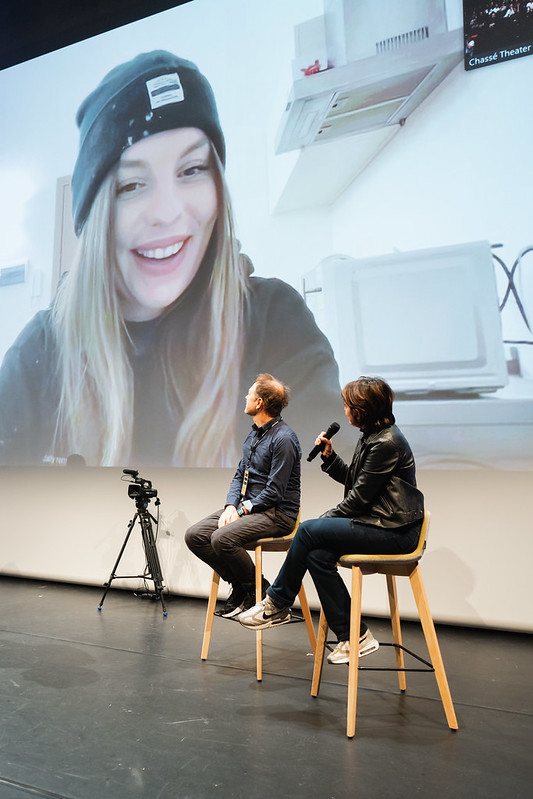
During the subsequent Q&A, director Deborah Faraone Mannella, originally from Italy, explained how her choice to focus on a singular mural—from its inception to completion—allowed her to weave a personal narrative that resonates universally. This approach mirrors Judith’s method, as she too paints individual moments that encapsulate a broader, universal meaning. Participating in the Q&A from Italy, where she is presently working on a new mural in Veneto, Judith expressed that she perceives her emotionally charged paintings find greater resonance in Italy than in the Netherlands, and she attributed this to the Italian appreciation for philosophy and emotions.
Concluding the discussion, Judith revealed that she stands at a pivotal juncture in her career. She envisions a future where her focus shifts more towards photography and video art than traditional painting.
“Girl Power” by SANY
Wrapping up the day was “Girl Power,” an anthology film by graffiti writer SANY hailing from Prague, Czech Republic. Released in 2016 after a decade of passionate and dedicated effort, the movie will soon be accessible on Netflix, so keep an eye out!
Until then, here’s the trailer of the first women’s graffiti documentary movie:
Before the screening, SANY wants to address the audience: in 2023, the need to make a film about women in graffiti may seem less urgent due to the increasing empowerment of girls in graffiti, albeit it remaining a predominantly male scene, thanks to the advent of social media. However, when SANY started painting in the ’90s in Prague, there were very few women doing graffiti, and social media didn’t exist. For her, this need was significant, prompting her to start collecting material for this film in the early 2000s. She traveled across Europe and the world, painting with and interviewing female graffiti writers, confronting challenges, and exchanging opinions.
The film serves as a valuable documentation of pioneers in the movement, such as Mick La Rock from Amsterdam and Musa71 from Barcelona, as well as all-female crews like Funky Girls from Italy and Puff Girls from Germany.
As she gathers material and faces setbacks along the way, including police persecution and equipment theft during filming, SANY connects with and visits women in different cities who share their experiences and narrate the unique flavor of the graffiti scene in their respective locations.
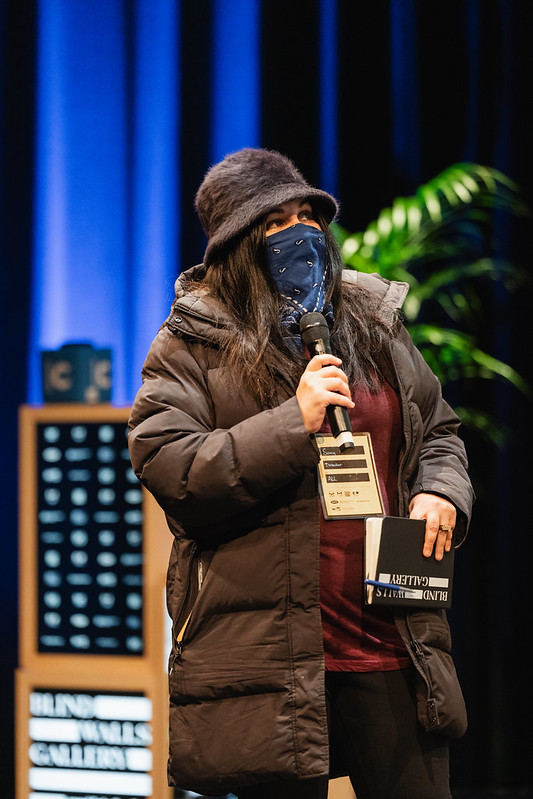
Alongside showcasing the most active female writers globally, the film seeks to explain graffiti culture and various scenes to an outsider audience. It enriches SANY’s footage with historical material and exclusive interviews, including testimonials from the first-ever female graffiti writer Lady Pink, the legendary graffiti photographer Martha Cooper, and the elusive Utah, who boldly declares, “I’m not a graffiti girl, I’m a graffiti writer.” Utah’s words aptly capture the spirit of resilience that fuels this film and sustained SANY despite numerous setbacks.
For decades, women have been told that graffiti is a male game, often belittled and marginalized. In graffiti, as in many other fields, women have had to work three times as hard as men to be noticed, recognized, and claim the space denied to them. The message echoed by all interviewed women, despite diverse backgrounds, ages, and cultures, is: “Women can do anything that men do.”
The graffiti movie “Girl Power” recounts these difficulties collectively, representing the voices and diverse opinions of a multitude of artists spanning different generations and cultures, a stark departure from the ego-centered male mentality prevalent in graffiti.
Blind Walls Film Fest: Day 3
The final day of the festival kicks off with a series of diverse short films, each offering a unique narrative. My personal favorite, and evidently the crowd’s favorite too, securing the Audience Choice Award, was the third work by Greek director George Gounezos— “Outer Space Kids.” The film unfolds the endeavors of local artist Sotiris and his crew, known as OSK (hence the movie’s title), as they take over an abandoned factory in Pyrgos, a city in the northwestern Peloponnese, Greece.
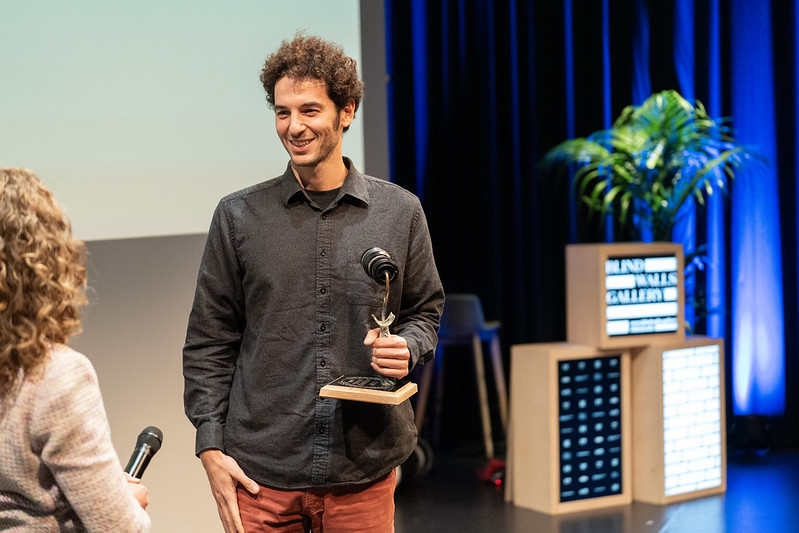
Throughout the movie, Sotiris and his fellow artists embraced this giant post-industrial space as a canvas for their creativity, free from the constraints of more formal settings like art galleries or ateliers. In this abandoned factory, their canvases stretched across vast walls, and their studio space spanned a generous 17.000 square meters. The artworks on the walls were very different from the typical graffiti pieces I’m used to find within abandoned factories. Instead, they were monochromatic, figurative pieces boasting a poignant style.
Sotiris’ distinctive style played a pivotal role in the project. The artist ventured into painting on the crumbling walls of the factory with the intention of experimentation, aiming to explore a style that he could have not developed on canvas with a gallery audience in mind. Throughout the film, the OSK crew transforms the abandoned factory into their haven, removing debris and cleaning the entire area to use it as their studio—a vast open space shared among different artists. With a DIY mentality inherent to graffiti, they repaired and refurbished the space, eventually opening it to the public with the unsanctioned art exhibition “2001” held proudly in August 2000—an event organized autonomously by the artists rather than art institutions.
Other short films featured in the selection included “City Work of Fiction” by Jonathan Pieterse, which received the Jury Award for shorts. The lineup encompassed the narrative of Avi, a Dutch female graffiti writer, a visual essay spotlighting the work of my friend and subvertiser Vermibus, a glimpse into the world of Greek muralist INO, and a documentary chronicling Keith Haring’s Grace mural, alongside various other urban narratives.
“Juste Ici et Pas Ailleurs” by MZM Projects
Following the shorts, the spotlight turned once again to MZM Projects with the screening of their latest film, showcasing the Bien Urbain public art festival. Titled “Juste Ici et Pas Ailleurs,” this poetic creation by my friends Kristina and Nazar narrates the evolution of one of the most authentic and respected festivals, taking place in Besançon, France.
Numerous elements in this film deeply resonated with me. I especially value the emergence of Kristina’s authorial voice halfway into the movie, marking a pivotal moment from 2019—the year she first participated in and documented the festival. (the documentary skillfully reconstructs the years from 2011 to 2018 using archival footage).
Also, the decision to infuse a unique musical theme for each festival edition, complemented by a diverse artist’s co-curation, adds a captivating layer to the narrative, akin to different chapters in a book.
We explored these facets and more during the Q&A session that I had the honor of moderating following the screening. Numerous interesting insights emerged during my conversation with Kristina Borhes and Bien Urbain’s artistic director, David Demougeot. I’ve decided to transcribe and share the Q&A on the blog for those who couldn’t attend the festival.
Enjoy the read!
- Read the transcript of the Q&A with MZM Projects and Bien Urbain following the screening of “Juste Ici et Pas Ailleurs” at Blind Walls Film Fest 2023.
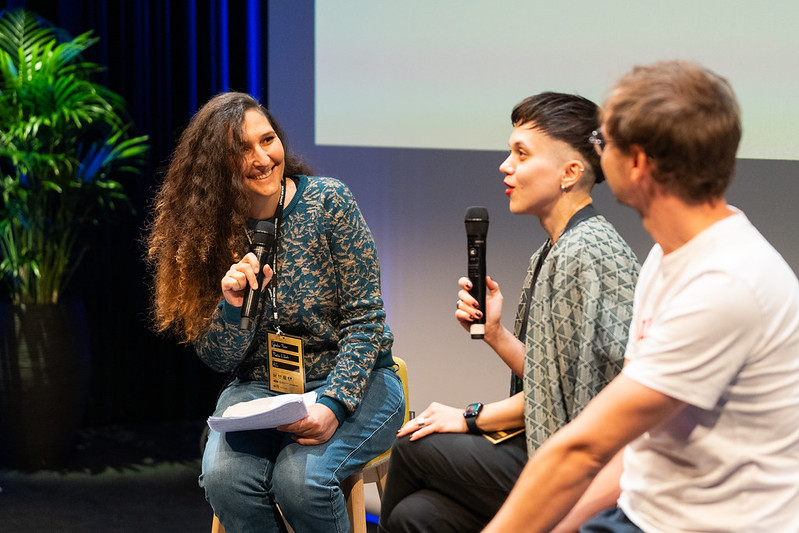
“Wild Style” by Charlie Ahearn
Finally, we wrapped up the second edition of Blind Walls Film Fest with the screening of the iconic movie “Wild Style” by Charlie Ahearn. I’ve actually enjoyed this classic graffiti film several times, but it’s always a fantastic experience, especially when it takes center stage on the big screen.
Watching this classic on the big screen is an immersive journey back to the roots of the artform. “Wild Style” is a pioneering film that immerses viewers into the vibrant world of hip-hop culture, capturing the beautiful innocence of the early days of the scene. Its narrative unfolds against the backdrop of New York City’s graffiti-laden landscapes, and the movie casts non-actors and real-life protagonists of the movement such as hip-hop legend Fab 5 Freddy alongside graffiti-writers Lee Quinonoes and Lady Pink, among many others.
A cinematic journey mirroring the very essence the Blind Walls Film Fest set out to celebrate, “Wild Style” served as a powerful reminder of the culture’s roots—particularly poignant as the culture recently celebrated its 40th anniversary.
Just as “Wild Style” stands as a pivotal documentation of hip-hop culture, the entire festival echoed the sentiment of preserving and honoring urban narratives. The power of video storytelling, highlighted in both the classic film and the diverse selection of documentaries and shorts, reinforces the importance of capturing ephemeral artforms like graffiti, street art, and muralism.
As the credits rolled on ‘Wild Style,’ we found ourselves completing a circle, returning to the roots of graffiti and reflecting on the profound influence of video documentation and storytelling, and their crucial role in preserving these narratives for generations to come.
Kristina Borhes‘ talk on the evolving genre of urban movies became a reflection of the festival itself—a genre characterized not just by fast-paced motion beats, spray cans and masked faces but by the genuine passion, creativity, and perseverance of artists pushing the boundaries of expression.
As we bid farewell to this year’s festival, the echoes of ‘Wild Style’ linger, a reminder that each spray of paint conceals a broader story waiting to be captured. Until the next edition, the resonance of these urban narratives will continue to shape and enrich our appreciation of urban art.
Enjoy the recap reel!
